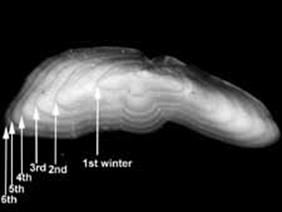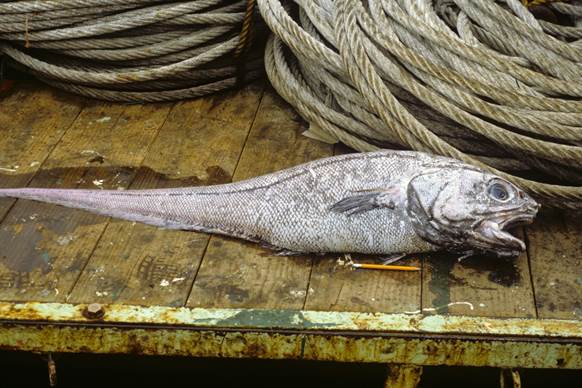“What would an ocean be without a monster lurking in the dark? It would be like sleep without dreams.” – Werner Herzog
The taxonomy of this fish has been controversial and while the species name pectoralis has remained constant scientists have struggled with the genus. It has been classified in the genus Macrurus, Albatrossia, Coryphaenoides (this is where I thought it recently resided) Nematonurus, and Chalinura. It was first described in 1892 – the American Fisheries Society has officially adopted Albatrossia as the genus but recent genetic work indicates it really is more closely related to those fish in the Coryphaenoides. A recent paper by biologists at the NOAA Fisheries lab in Juneau indicates that AFS may change the genus based on this information, again, in the near future.
Albatrossia – the name of an oceanographic ship, “Albatross” (1888-1900) and pectoralis – referring to the long and narrow pectoral fin. The Albatross was a ship of the Fisheries Commission – forerunner of NOAA Fisheries, that sailed the world on oceanographic investigations. Roy Chapman Andrews of the American Museum of Natural History, a man who many believe was the model for Steven Spielberg’s Indiana Jones, sailed on the Albatross during its Philippine expedition of 1907-1910.
This is a deep sea fish of the west coast that is particularly abundant in the Gulf of Alaska, usually found in water depths greater than 900 ft., though it ranges through the water column at depths of 400 to 6,000 ft. The grenadier family (Macrouridae) includes 300 world-wide species of which this critter is the largest. They can exceed 59 inches and 90 lbs. Measuring them can be difficult because they are often brought up in deep sea trawls, which break off their long tails. Age and growth studies on the species are limited but the available data indicate they can live over 50 years, while commercially caught species from the same genus in the Atlantic live up to 70 years. So how do you age these fish? By reading their otoliths, commonly known as earstones, which are calcium carbonate structures behind the brain of bony fishes. Just as in tree rings, fish growth patterns vary and show a slow and fast growth period during the year and the annual layers can be counted.

Because the species lives in such depths there are a lot of phrases like this in the literature: Very little is known about the life history of the giant grenadier. No larvae of the species have ever been collected and juveniles in trawl nets are very uncommon. One study indicated that all fish caught deeper than 2,000 ft were females – providing speculation that there may be some vertical migration of one or both sexes for spawning purposes – but really, who knows? Some Russian studies indicate that seasonal feeding and spawning migrations occur up to “several hundred miles”. Stock structure in Alaska and migration patterns are unknown – fish cannot be tagged because all individuals die due to barotrauma (pressure differences) when brought to the surface.
Surveys show that females are longer, larger (2x the weight) and twice as abundant as males. There is an inverse relationship between fish size and occupied depth – smaller fish are found in deeper waters. This is in contrast to “Heincke’s Law”, after a 20th century biologist who first noticed in the North Sea that fish of the same species found deeper were generally larger. Of course – it’s not clear why this is so with the giant grenadier.
Adults are known to concentrate along the sea floor as they are they are captured in large numbers by trawls and longlines set on the bottom. Stomachs of giant grenadiers show an abundance of bathypelagic (in the water column) squid and fish with little evidence of benthic (bottom) feeding. So while they appear to congregate near the bottom they are feeding on prey in the deep water and not on the surface of the sea floor. The only documented predators of this fish include sleeper sharks (Somniosus pacificus) and Baird’s beaked whales (Beradius bairdii) – both from stomach samples of these species. Those who study this fish speculate that it also is preyed upon by sperm whales (Physeter macrocephalus). Short video: https://www.youtube.com/watch?feature=player_embedded&v=kA-Zbxf6BFk
The fish was up until recently considered a “nonspecified species” by the U.S. North Pacific Fisheries Management Council (NPFMC), which is responsible for setting fish quotas in Alaskan waters. Thus, grenadiers were not included in any management plans and there were no restrictions on their catch or retention and there were no catch reporting requirements. After developing several policy papers the NPFMC proposed in 2012 to move grenadiers into the groundfish group for management – the proposal was approved in early 2014. Reporting requirements will now be required but no catch limits are set. But a lot of these fish are being caught and discarded – in 2005 records indicate that about 11 metric tons were caught in the combined Bering Sea, Gulf of Alaska, and Aleutian Island zones.
Given the available biomass and that it is not used, there have been several attempts to develop a market for the fish – first as surimi, which is basically ground-up fish formed into patties. This was back in 1998 and it never took off. A second try for fish roe and filets also fell flat in 2005 – but efforts are ongoing. So keep an eye out at Whole foods, but my advice would be to avoid selling it as whole fish and scaring off most customers. There are a lot of these fish out there. Based on survey data in 2003 NOAA estimated the total biomass of these fish, just in the Gulf of Alaska, to be 6,503,760,627 metric tons!!!! A metric ton is 1,000 kg or 2,205 lbs – you can do the math. But even given these large occurrence numbers there is concern that the large bycatch (unintended catch) of the species is not a good thing.
I know this species as the pectoral rattail, an alternate name. This photo was taken on the Fukuyoshi Maru #38, which was my home for 10 weeks while it fished in the Gulf of Alaska. I was serving as a Fisheries Observer, taking data for the NOAA Fisheries NW Fisheries Science Center. This was a relatively small trawler (50 m long) that pulled a net along the sea floor – mostly after pollock.
I didn’t see many of these species but every once in a while we would run into them. On day the trawl net came up and I scurried to my position below deck to see what was going to be dumped into the hatch to the holding area before processing. There were a few fish dropped, a short delay, and then about 100 pectoral rattails were dumped. That was it. A decent catch was 5 metric tons of ground fish (if I remember correctly) – but this catch of “trash” fish was not a good effort.
I looked across at the elderly fishing master with the usual charch between his lips. He looked at me, tightened his jaw, shook his head, and slowly walked back upstairs to the bridge mumbling between puffs.
